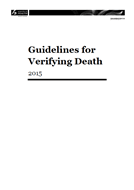
Summary
The Guidelines for Verifying Death has been developed to support practitioners and to provide information to employers and organisations about the process for verifying death and the role related activities involved when someone dies.
Verification of death means the act of establishing that a person is dead and recording the time, place and date of that assessment. Verification of death is established through clinical assessment for the absence of signs of life.
Medical practitioners, nurse practitioners, registered nurses, enrolled nurses, midwives, emergency medical technicians, paramedics and intensive care paramedics are allowed by the Chief Coroner to verify death, including deaths which meet the criteria for reporting to the Coroner.
In most cases, the health practitioner who verifies death and documents the assessment will be requested to do so by the Police because the death is a coronial case.
